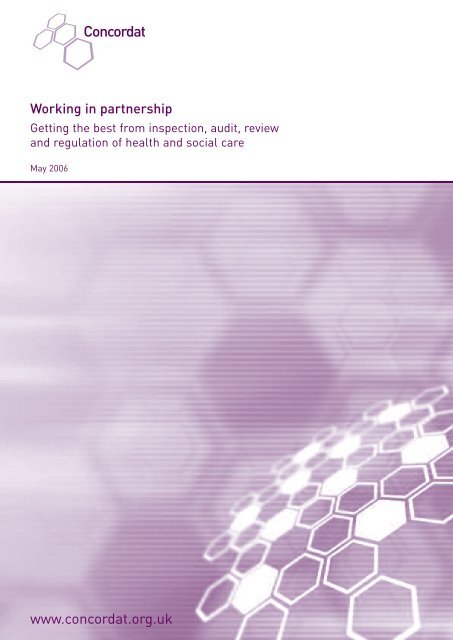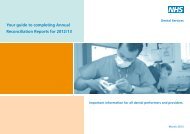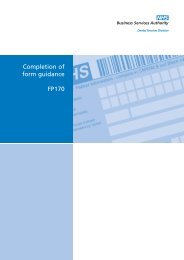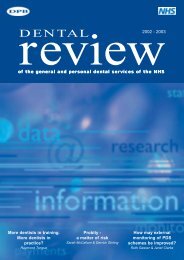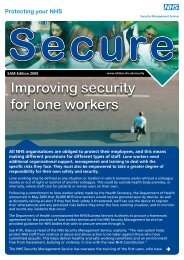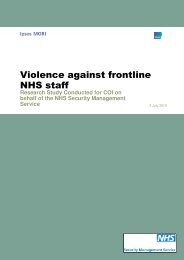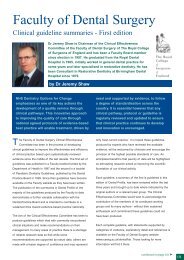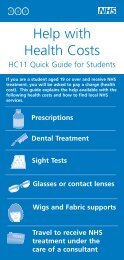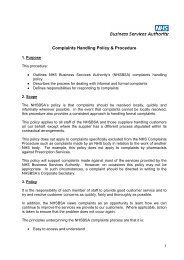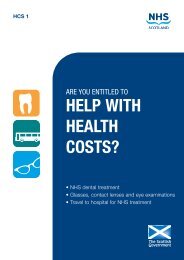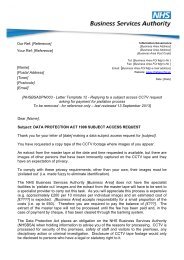Working in partnership: Getting the best from inspection, audit ...
Working in partnership: Getting the best from inspection, audit ...
Working in partnership: Getting the best from inspection, audit ...
- No tags were found...
Create successful ePaper yourself
Turn your PDF publications into a flip-book with our unique Google optimized e-Paper software.
<strong>Work<strong>in</strong>g</strong> <strong>in</strong> <strong>partnership</strong>Gett<strong>in</strong>g <strong>the</strong> <strong>best</strong> <strong>from</strong> <strong>in</strong>spection, <strong>audit</strong>, reviewand regulation of health and social careMay 2006www.concordat.org.ukConcordat Gett<strong>in</strong>g <strong>the</strong> <strong>best</strong> <strong>from</strong> <strong>in</strong>spection, <strong>audit</strong>, review and regulation of health and social care May 20061
Steve BundredAudit CommissionDenise LievesleyThe Information CentreGeoffrey PodgerHealth and Safety ExecutiveSandy ForrestCouncil for HealthcareRegulatory ExcellenceJohn RogersSkills for HealthAnna WalkerHealthcare CommissionSteve WalkerNHS Litigation AuthorityChris Heg<strong>in</strong>bothamMental Health Act CommissionPaul StreetsPostgraduate Medical Educationand Tra<strong>in</strong><strong>in</strong>g BoardJim GeeNHS Counter Fraud and SecurityManagement Service
David BehanCommission for Social CareInspectionF<strong>in</strong>lay ScottGeneral Medical CouncilCOPMeDGraham W<strong>in</strong>wardCOPMeDPeter HigsonHealthcare Inspectorate WalesGill MorganThe NHS ConfederationAngela McNabHuman Fertilisation EmbryologyAuthorityAlan CraftAcademy of Medical Royal CollegesRt Hon Jane Kennedy MPDepartment of HealthAnna SimonsNational Audit OfficePeter WilliamsQuality Assurance Agency forHigher Education
First published June 2005. Updated <strong>in</strong> May 2006.© 2006 Commission for Healthcare Audit and InspectionItems may be reproduced free of charge <strong>in</strong> any format ormedium provided that <strong>the</strong>y are not for commercial resale.This consent is subject to <strong>the</strong> material be<strong>in</strong>g reproducedaccurately and provided that it is not used <strong>in</strong> a derogatorymanner or mislead<strong>in</strong>g context.The material should be acknowledged as © 2006 Commissionfor Healthcare Audit and Inspection with <strong>the</strong> title of <strong>the</strong>document specified.Applications for reproduction should be made <strong>in</strong> writ<strong>in</strong>g to:Chief Executive, Commission for Healthcare Audit andInspection, 103-105 Bunhill Row, London, EC1Y 8TG.ISBN 1-84562-098-4
ContentsForeword by Rt Hon Jane Kennedy 5Introduction 6Objective oneInspections are coord<strong>in</strong>ated with o<strong>the</strong>r reviews and collectionsof data 9Objective twoInspections of healthcare focus on <strong>the</strong> experiences of patients,o<strong>the</strong>r people who use services and carers 11Objective threeInspections support improvements <strong>in</strong> quality and performance 12Objective fourInspect<strong>in</strong>g bodies cont<strong>in</strong>uously improve <strong>the</strong>ir methods 13Objective fiveInspections are <strong>in</strong>dependent, consistent and fair 15Objective sixInspections are targeted and proportionate 16Objective sevenInspections are transparent and accountable 17Objective eightInspect<strong>in</strong>g bodies use coord<strong>in</strong>ated and proportionatemethods of enforcement 18Objective n<strong>in</strong>eInspectors are suitably qualified, tra<strong>in</strong>ed and skilled 19Objective 10Inspect<strong>in</strong>g bodies cont<strong>in</strong>uously monitor <strong>the</strong>ir practices <strong>in</strong> l<strong>in</strong>ewith <strong>the</strong> Concordat 20Appendix ABackground 21Appendix BSignatories to <strong>the</strong> Concordat 24References 35Concordat Gett<strong>in</strong>g <strong>the</strong> <strong>best</strong> <strong>from</strong> <strong>in</strong>spection, <strong>audit</strong>, review and regulation of health and social care May 2006 3
4 Concordat Gett<strong>in</strong>g <strong>the</strong> <strong>best</strong> <strong>from</strong> <strong>in</strong>spection, <strong>audit</strong>, review and regulation of health and social care May 2006
ForewordThe Government’s cont<strong>in</strong>u<strong>in</strong>g programme of <strong>in</strong>vestment and reform <strong>in</strong>healthcare is deliver<strong>in</strong>g more and improved services through a mix of publicand private sector providers.We want to make sure that this <strong>in</strong>vestment is maximised and that standards areconsistent right across healthcare. Regulation is an important element of this.It helps provide assurance to <strong>the</strong> public and to improve services. But to get <strong>the</strong><strong>best</strong> out of <strong>the</strong> system, effective and targeted regulation is vital. The regulatoryregime must be uncomplicated. It must be transparent and <strong>in</strong>dependent. But<strong>in</strong>dependence does not mean that <strong>the</strong>re is no dialogue between organisations.We have to make sure that <strong>the</strong> <strong>in</strong>spection regime for healthcare is jo<strong>in</strong>ed up, toremove duplication and overlap.The Government believes that <strong>the</strong> potential ga<strong>in</strong>s <strong>from</strong> stripp<strong>in</strong>g awayunnecessary regulation and duplication of activity are enormous. The Concordatwas developed to provide a code of objectives and practices for both Governmentand <strong>in</strong>dependent <strong>in</strong>spectorates to deliver smarter, more jo<strong>in</strong>ed up <strong>in</strong>spectionprogrammes that reduce <strong>the</strong> burdens of <strong>in</strong>spection on healthcare staff. We havealready announced that <strong>the</strong> number of public services <strong>in</strong>spectorates will reduce<strong>from</strong> 11 to four by 2007 and <strong>the</strong> merg<strong>in</strong>g of <strong>in</strong>spectorates will cut down repeatrequests for <strong>in</strong>formation and <strong>the</strong> number of visits <strong>from</strong> <strong>in</strong>spectors.So Government is develop<strong>in</strong>g <strong>the</strong> future landscape. But <strong>in</strong>spectorates must alsoseize <strong>the</strong> <strong>in</strong>itiative. That is why <strong>the</strong> Concordat is so important. It sets out anumber of pr<strong>in</strong>ciples and priorities to which all <strong>in</strong>spectorates should work.S<strong>in</strong>ce <strong>the</strong> Concordat was launched <strong>in</strong> June 2004 good progress has been madeon implementation. Under <strong>the</strong> leadership of <strong>the</strong> Healthcare Commission <strong>the</strong>rehas been a significant amount of work to get <strong>the</strong> basics <strong>in</strong> place. There havebeen some notable examples of better practice. However, <strong>the</strong>re needs now tobe a step change towards demonstrable action.We welcome <strong>the</strong> addition of <strong>the</strong> new members, <strong>the</strong> enhancement of <strong>the</strong> code ofobjectives and practices by fur<strong>the</strong>r guidance and <strong>the</strong> new web-basedschedul<strong>in</strong>g tool for signatories and healthcare organisations. The develop<strong>in</strong>gl<strong>in</strong>ks between <strong>the</strong> English and Welsh Concordats are very encourag<strong>in</strong>g.Inspectorates are <strong>in</strong>creas<strong>in</strong>gly mov<strong>in</strong>g to more risk-based approaches to<strong>in</strong>spection that shift resources away <strong>from</strong> rout<strong>in</strong>e <strong>in</strong>spection <strong>in</strong> safer areas witha proven track record, towards services <strong>in</strong> areas of higher risk, regulat<strong>in</strong>g onlywhere necessary, and <strong>in</strong> a light touch way that is proportionate to risk.Inspectorates must cont<strong>in</strong>ue to identify and remove overlap and duplicationcreated by <strong>the</strong> system of <strong>in</strong>spection as experienced by frontl<strong>in</strong>e staff.Rt Hon Jane Kennedy MPDepartment of HealthConcordat Gett<strong>in</strong>g <strong>the</strong> <strong>best</strong> <strong>from</strong> <strong>in</strong>spection, <strong>audit</strong>, review and regulation of health and social care May 2006 5
IntroductionThe ConcordatThe Concordat is a voluntary agreement between organisations that regulate,<strong>audit</strong>, <strong>in</strong>spect or review elements of health and social care <strong>in</strong> England. It waslaunched <strong>in</strong> June 2004 by 10 organisations, led by <strong>the</strong> Healthcare Commission.There are now 20 signatories work<strong>in</strong>g toge<strong>the</strong>r to coord<strong>in</strong>ate <strong>the</strong>ir activitiessuch as <strong>audit</strong>s, reviews and <strong>in</strong>spections. By streaml<strong>in</strong><strong>in</strong>g <strong>the</strong>ir activities, <strong>the</strong>sesignatories are support<strong>in</strong>g <strong>the</strong> improvement of health services for <strong>the</strong> public.The Concordat sets out what bodies provid<strong>in</strong>g healthcare <strong>in</strong> England can expect<strong>from</strong> <strong>the</strong> ma<strong>in</strong> <strong>in</strong>spect<strong>in</strong>g bodies. It forms <strong>the</strong> basis of a programme to developand implement policies for <strong>in</strong>spection that are based on sound objectives andpractices. By <strong>in</strong>spection, we mean <strong>audit</strong>s, reviews, assessments and <strong>the</strong>regulation of services. The Concordat is designed to support <strong>the</strong> improvementof services for <strong>the</strong> public and to reduce unnecessary burdens on frontl<strong>in</strong>e staff.The Concordat:• has been agreed by <strong>the</strong> signatories, which are listed <strong>in</strong> Appendix B, and <strong>the</strong>Cab<strong>in</strong>et Office• is led by <strong>the</strong> Healthcare Commission, which has a statutory responsibility topromote <strong>the</strong> effective coord<strong>in</strong>ation of reviews or assessments relat<strong>in</strong>g to <strong>the</strong>provision of healthcare by or for <strong>the</strong> NHS <strong>in</strong>clud<strong>in</strong>g cross border specialhealth authorities• fulfils a commitment <strong>in</strong> Mak<strong>in</strong>g a difference: reduc<strong>in</strong>g burdens <strong>in</strong> healthcare<strong>in</strong>spection and monitor<strong>in</strong>g, Department of Health, Cab<strong>in</strong>et Office (2003). Actionone of this report announced <strong>the</strong> development of a Concordat on <strong>the</strong> <strong>in</strong>spectionof healthcare between review<strong>in</strong>g bodies and providers of healthcare.This Concordat is concerned predom<strong>in</strong>ately with <strong>the</strong> <strong>in</strong>spection of organisationsprovid<strong>in</strong>g health and social care. However, <strong>the</strong> signatories recognise thatpatients and clients often receive care or support <strong>from</strong> several agencies andthat <strong>the</strong> effective delivery of social care is an important aspect of <strong>the</strong>ir overallcare and experience. The Commission for Social Care Inspection (CSCI) is asignatory to this Concordat and will ensure that arrangements are developedfor social care services that are consistent with its pr<strong>in</strong>ciples. In order todevelop ’holistic’ approaches, CSCI is develop<strong>in</strong>g substantial programmes ofjo<strong>in</strong>t <strong>in</strong>spection with <strong>the</strong> Healthcare Commission, as well as with bodies suchas Office for Standards <strong>in</strong> Education (Ofsted) and <strong>the</strong> Audit Commission. It<strong>in</strong>tends to shape those programmes <strong>in</strong> l<strong>in</strong>e with <strong>the</strong> pr<strong>in</strong>ciples of <strong>the</strong> Concordatand will keep its progress <strong>in</strong> this area under close review.6Concordat Gett<strong>in</strong>g <strong>the</strong> <strong>best</strong> <strong>from</strong> <strong>in</strong>spection, <strong>audit</strong>, review and regulation of health and social care May 2006
ObjectivesThe Concordat has been developed by <strong>the</strong> <strong>in</strong>spect<strong>in</strong>g bodies, <strong>in</strong> conjunction withhealth services. It is made up of 10 objectives that enable organisations to worktoge<strong>the</strong>r to remove unnecessary burdens associated with <strong>in</strong>spections, <strong>audit</strong>s orreviews. Each objective is underp<strong>in</strong>ned by a number of practices that are aimedat ensur<strong>in</strong>g that <strong>the</strong> objectives of <strong>the</strong> Concordat are be<strong>in</strong>g met.It identifies 10 objectives that are aimed at:• deliver<strong>in</strong>g more consistent and coherent programmes of <strong>in</strong>spection• improv<strong>in</strong>g services for patients, clients and <strong>the</strong>ir carers• reduc<strong>in</strong>g unnecessary burdens of <strong>in</strong>spection on staff provid<strong>in</strong>g healthcareUnderp<strong>in</strong>n<strong>in</strong>g <strong>the</strong>se objectives are a number of practices that will help tosecure effective implementation. The development and operation of suchpractices will take account of:• formal and <strong>in</strong>formal agreements between <strong>in</strong>spect<strong>in</strong>g bodies• <strong>in</strong>spect<strong>in</strong>g bodies’ respective statutory remits and relevant professionalstandards• <strong>the</strong> extent to which particular practices would enable bodies to fulfil <strong>the</strong>ir<strong>in</strong>dividual or collective functionsThe aim is to achieve greater consistency and cohesion <strong>in</strong> <strong>the</strong> <strong>in</strong>spection ofhealth and healthcare. However, while <strong>the</strong> closer alignment of methodologiesmay often be beneficial, <strong>the</strong> Concordat’s <strong>in</strong>tention is not to impose a s<strong>in</strong>gle<strong>in</strong>spection methodology or to replace <strong>the</strong> exist<strong>in</strong>g methodologies that <strong>best</strong> meet<strong>the</strong> needs of <strong>the</strong> services for which <strong>the</strong>y have been developed. Equally, <strong>the</strong>Concordat does not affect <strong>the</strong> statutory remit of <strong>in</strong>dividual <strong>in</strong>spect<strong>in</strong>g bodies.Where <strong>the</strong>re is any overlap or conflict <strong>in</strong> statutory remits, <strong>the</strong> bodies concernedwill seek to manage this effectively.SignatoriesSo far 20 organisations <strong>in</strong>volved <strong>in</strong> <strong>the</strong> regulation, <strong>audit</strong> or review of health andsocial care have signed up to <strong>the</strong> Concordat. There are two types of signatories:• full signatoriesFull signatories are those organisations that directly or <strong>in</strong>directly regulate,<strong>audit</strong> or review health or social care <strong>in</strong> England and/or rout<strong>in</strong>ely requestdata <strong>from</strong>, or carry out <strong>in</strong>spections of, NHS organisations and providers of<strong>in</strong>dependent healthcare.Concordat Gett<strong>in</strong>g <strong>the</strong> <strong>best</strong> <strong>from</strong> <strong>in</strong>spection, <strong>audit</strong>, review and regulation of health and social care May 2006 7
Introduction cont<strong>in</strong>ued• associate signatoriesAssociate signatories are those organisations that may not directlyundertake <strong>in</strong>spection, <strong>audit</strong> or review of health or social care <strong>in</strong> Englandbut whose work is closely associated with <strong>the</strong> pr<strong>in</strong>ciples and objectives of<strong>the</strong> Concordat.A full list of signatories is available <strong>in</strong> Appendix B.The Government’s approachThe Concordat is consistent with <strong>the</strong> Government’s policy on <strong>the</strong> <strong>in</strong>spection ofpublic services, and <strong>the</strong> 10 pr<strong>in</strong>ciples that support that policy, which are found<strong>in</strong> Inspect<strong>in</strong>g for improvement: Develop<strong>in</strong>g a customer focused approach (Office ofPublic Services Reform, July 2003).Audits of f<strong>in</strong>ancial statements are not covered by <strong>the</strong> Concordat.CommitmentThe signatories will work with <strong>the</strong> Department of Health, <strong>the</strong> Cab<strong>in</strong>et Office,o<strong>the</strong>r <strong>in</strong>spect<strong>in</strong>g and <strong>in</strong>terested bodies, and those who use, provide or o<strong>the</strong>rwisecontribute to <strong>the</strong> quality, safety and cost effectiveness of healthcare cont<strong>in</strong>uouslyto improve and review <strong>the</strong> Concordat and <strong>the</strong> practices it promotes. They willseek ways of <strong>in</strong>clud<strong>in</strong>g <strong>the</strong> practices of <strong>the</strong> Concordat <strong>in</strong> <strong>the</strong>ir work with o<strong>the</strong>rbodies and to encourage relevant bodies to adopt <strong>the</strong> Concordat. The signatorieshave established <strong>the</strong> Health and Social Care Inspection Forum to oversee <strong>the</strong>effective implementation of <strong>the</strong> practices <strong>in</strong> <strong>the</strong> Concordat. The forum will workclosely with <strong>the</strong> Local Services Inspectorates Forum, which coord<strong>in</strong>ates practice<strong>in</strong> relation to local government. The Local Services Inspectorates Forum ischaired by <strong>the</strong> Audit Commission and considers strategic issues relat<strong>in</strong>g to <strong>the</strong><strong>in</strong>spection of local authorities.Geographical coverageThe Concordat currently applies to England, but signatories with a remit <strong>in</strong>Wales will extend its pr<strong>in</strong>ciples to <strong>the</strong>ir pr<strong>in</strong>cipalities.The implications for those signatories (<strong>in</strong>clud<strong>in</strong>g potential signatories) that havea UK wide remit will be addressed.8Concordat Gett<strong>in</strong>g <strong>the</strong> <strong>best</strong> <strong>from</strong> <strong>in</strong>spection, <strong>audit</strong>, review and regulation of health and social care May 2006
Objective oneInspections are coord<strong>in</strong>ated with o<strong>the</strong>r reviewsand collections of dataPractice 1.1Def<strong>in</strong>e and expla<strong>in</strong> remit to ensure clarity and effectivecoord<strong>in</strong>ationInspect<strong>in</strong>g bodies def<strong>in</strong>e <strong>the</strong>ir remit, avoid<strong>in</strong>g any <strong>in</strong>appropriate expansion andexpla<strong>in</strong><strong>in</strong>g <strong>in</strong> annual plans and reports how <strong>the</strong>y aim to cover that remit. This iscommunicated to professional, patient and client groups and o<strong>the</strong>rs, <strong>in</strong>clud<strong>in</strong>go<strong>the</strong>r <strong>in</strong>spectorates. The annual plan sets out <strong>the</strong> <strong>in</strong>spect<strong>in</strong>g body’s annualgoals and objectives.As <strong>in</strong>spect<strong>in</strong>g bodies develop <strong>the</strong>ir annual plans and reports, <strong>the</strong>y share <strong>the</strong>mwith o<strong>the</strong>r <strong>in</strong>spect<strong>in</strong>g bodies to assist <strong>the</strong> development of coord<strong>in</strong>atedprogrammes of work, <strong>in</strong>clud<strong>in</strong>g, where necessary, methodologies of <strong>in</strong>spection.Practice 1.2Use exist<strong>in</strong>g data setsInspect<strong>in</strong>g bodies consider <strong>the</strong> suitability of exist<strong>in</strong>g data sets, which are sets of<strong>in</strong>formation that can be analysed, and maximise <strong>the</strong>ir legitimate use of<strong>in</strong>formation <strong>from</strong> o<strong>the</strong>r <strong>in</strong>spect<strong>in</strong>g bodies. Inspect<strong>in</strong>g bodies do not requestfur<strong>the</strong>r <strong>in</strong>formation until <strong>the</strong> adequacy of exist<strong>in</strong>g <strong>in</strong>formation has been taken<strong>in</strong>to account.Inspect<strong>in</strong>g bodies coord<strong>in</strong>ate <strong>the</strong>ir core data, <strong>in</strong>formation and developmentalrequirements. They communicate <strong>the</strong>se to <strong>in</strong>spected bodies and coord<strong>in</strong>ate<strong>the</strong>ir collection arrangements.Inspect<strong>in</strong>g bodies put <strong>in</strong> place processes for manag<strong>in</strong>g and rationalis<strong>in</strong>gcommunications with <strong>the</strong> NHS about <strong>in</strong>spection programmes and requestsfor <strong>in</strong>formation.Practice 1.3Share <strong>in</strong>formation with o<strong>the</strong>r bodiesSubject to agreed protocols (for example, regard<strong>in</strong>g <strong>the</strong> use of confidentialpersonal <strong>in</strong>formation), <strong>in</strong>spect<strong>in</strong>g bodies share relevant <strong>in</strong>formation with eacho<strong>the</strong>r to ensure <strong>the</strong>re is no duplication of collection and that maximum value isobta<strong>in</strong>ed <strong>from</strong> <strong>the</strong> <strong>in</strong>formation collected. Where <strong>the</strong>re are legal, regulatory ororganisational barriers, <strong>in</strong>spect<strong>in</strong>g bodies follow <strong>the</strong> pr<strong>in</strong>ciples set out <strong>in</strong> <strong>the</strong>Department for Constitutional Affairs’ toolkit for <strong>the</strong> shar<strong>in</strong>g of data 1 and/orconsider referr<strong>in</strong>g it to <strong>the</strong> relevant Government department with arecommendation for a Regulatory Reform Order (RRO) 2 .Concordat Gett<strong>in</strong>g <strong>the</strong> <strong>best</strong> <strong>from</strong> <strong>in</strong>spection, <strong>audit</strong>, review and regulation of health and social care May 2006 9
Objective one cont<strong>in</strong>uedPractice 1.4Plann<strong>in</strong>g <strong>in</strong>spectionsInspect<strong>in</strong>g bodies coord<strong>in</strong>ate <strong>the</strong>ir <strong>in</strong>spections, reviews and monitor<strong>in</strong>g activityand, where appropriate, develop shared methodologies and <strong>in</strong>spect jo<strong>in</strong>tly. Theydevelop mechanisms to support <strong>the</strong>se procedures. When <strong>in</strong>spections take placeseparately, <strong>in</strong>spect<strong>in</strong>g bodies consult each o<strong>the</strong>r and <strong>in</strong>spected bodies as to howand with whom <strong>in</strong>formation and f<strong>in</strong>d<strong>in</strong>gs will be shared.Inspect<strong>in</strong>g bodies develop means for shar<strong>in</strong>g <strong>the</strong>ir plans for <strong>in</strong>spection <strong>in</strong>order to create a unified schedule. This is communicated to <strong>the</strong> NHS ando<strong>the</strong>r relevant bodies. Subject to ma<strong>in</strong>ta<strong>in</strong><strong>in</strong>g <strong>the</strong> effective use ofunannounced <strong>in</strong>spections <strong>in</strong> certa<strong>in</strong> circumstances, <strong>in</strong>spect<strong>in</strong>g bodies provideadvance notice of rout<strong>in</strong>e <strong>in</strong>spections.Practice 1.5Reliance on o<strong>the</strong>r <strong>in</strong>spect<strong>in</strong>g bodies’ f<strong>in</strong>d<strong>in</strong>gsSubject to <strong>the</strong>ir statutory remit, <strong>in</strong>spect<strong>in</strong>g bodies develop a reliance on <strong>the</strong>results of reviews carried out by o<strong>the</strong>r competent organisations. They aim toavoid replicat<strong>in</strong>g <strong>in</strong>spections <strong>in</strong> areas that have been <strong>in</strong>spected recently byo<strong>the</strong>rs. To support this process, <strong>in</strong>spect<strong>in</strong>g bodies demonstrate <strong>the</strong> robustnessof <strong>the</strong>ir processes and f<strong>in</strong>d<strong>in</strong>gs.Where <strong>the</strong>re are regulatory or organisational barriers, bodies consider if <strong>the</strong>secould be overcome by referr<strong>in</strong>g <strong>the</strong>m to <strong>the</strong> relevant Government departmentwith a recommendation for a Regulatory Reform Order (RRO) 2 .10 Concordat Gett<strong>in</strong>g <strong>the</strong> <strong>best</strong> <strong>from</strong> <strong>in</strong>spection, <strong>audit</strong>, review and regulation of health and social care May 2006
Objective threeInspections support improvements <strong>in</strong> qualityand performancePractice 3.1Recognise improvement and good practiceInspect<strong>in</strong>g bodies ensure, through objective assessment, that improvementand <strong>best</strong> practice <strong>in</strong> <strong>the</strong> provision of health and social care are identified andrecognised.Practice 3.2Spread good practice, encourage <strong>in</strong>novation and learn <strong>from</strong>experiencesInspect<strong>in</strong>g bodies ensure that <strong>in</strong>formation about <strong>the</strong> <strong>best</strong> and/or most<strong>in</strong>novative practices <strong>the</strong>y identify dur<strong>in</strong>g <strong>in</strong>spections is communicated torelevant agencies. They draw attention to areas of improvement, and how thathas been achieved, and share views and <strong>in</strong>formation about how improvedperformance might be encouraged. Inspect<strong>in</strong>g bodies identify unsatisfactorypractices so that o<strong>the</strong>rs can take corrective action where necessary.Practice 3.3Focus on improv<strong>in</strong>g care and outcomes for people who use servicesInspect<strong>in</strong>g bodies focus as far as possible on outcomes for health and socialcare. Where relevant, this <strong>in</strong>cludes <strong>the</strong> contribution and needs of staff andtra<strong>in</strong>ees, m<strong>in</strong>imis<strong>in</strong>g risks to staff and secur<strong>in</strong>g better value for money.Practice 3.4Contribute to <strong>the</strong> development and delivery of policyRelevant <strong>in</strong>formation <strong>from</strong> <strong>in</strong>spections is used to <strong>in</strong>form <strong>the</strong> development ofpolicy and <strong>the</strong> evaluation of its delivery. The Department of Health and<strong>in</strong>spect<strong>in</strong>g bodies form <strong>partnership</strong>s with national, regional and local policymakers, performance managers, support<strong>in</strong>g organisations (such as <strong>the</strong>Modernisation Agency) and those responsible for delivery.Practice 3.5Facilitate self assessment and cont<strong>in</strong>uous improvement of servicesWhere appropriate, <strong>in</strong>spect<strong>in</strong>g bodies provide support and guidance tohealthcare bodies and <strong>the</strong>ir staff to develop tools for self assessment that cancontribute to <strong>the</strong> cont<strong>in</strong>uous measurement, improvement and culturalsuitability of services.12 Concordat Gett<strong>in</strong>g <strong>the</strong> <strong>best</strong> <strong>from</strong> <strong>in</strong>spection, <strong>audit</strong>, review and regulation of health and social care May 2006
Objective fourInspect<strong>in</strong>g bodies cont<strong>in</strong>uously improve <strong>the</strong>irmethodsPractice 4.1Evaluat<strong>in</strong>g and revis<strong>in</strong>g standards/criteriaThere are regular and def<strong>in</strong>ed processes for evaluat<strong>in</strong>g and revis<strong>in</strong>g <strong>the</strong>standards, criteria, questions and relevant <strong>in</strong>formation used by <strong>in</strong>spect<strong>in</strong>gbodies. Inspect<strong>in</strong>g bodies seek ways of align<strong>in</strong>g <strong>the</strong>ir approaches where it isconsistent with <strong>the</strong> effective discharge of <strong>the</strong>ir functions and assists sharedor coord<strong>in</strong>ated programmes of <strong>in</strong>spection. Any legislative barriers arereferred to <strong>the</strong> relevant Government departments.Practice 4.2Long term evaluation of cost and benefitInspect<strong>in</strong>g bodies <strong>in</strong>stigate a cont<strong>in</strong>u<strong>in</strong>g programme to evaluate <strong>the</strong> broadimpact of <strong>in</strong>spections, <strong>in</strong>clud<strong>in</strong>g <strong>the</strong> impact on healthcare bodies and <strong>the</strong>wider community. These take <strong>in</strong>to account direct and <strong>in</strong>direct operationalcosts and benefits, as well as <strong>the</strong> costs and benefits of compliance 4 .Inspect<strong>in</strong>g bodies put procedures <strong>in</strong> place to evaluate <strong>the</strong> extent to which<strong>in</strong>spection has contributed to improv<strong>in</strong>g healthcare and/or o<strong>the</strong>r relevant (forexample, operational, value for money or environmental) improvements.Published reports help to <strong>in</strong>form <strong>the</strong> plann<strong>in</strong>g and revision of methodologies.Practice 4.3Pilot and assessment of major changes or new <strong>in</strong>spectionsInspect<strong>in</strong>g bodies fully assess <strong>the</strong> costs and benefits of major changes to<strong>in</strong>spections and, where appropriate, pilot new processes to ensure that <strong>the</strong>yare practical, efficient and effective and contribute to service or o<strong>the</strong>r relevantimprovements.Practice 4.4Ga<strong>the</strong>r and act on feedback <strong>from</strong> those who receive orprovide healthcareInspect<strong>in</strong>g bodies collect feedback <strong>from</strong> <strong>in</strong>spected bodies, and those who use<strong>the</strong> services and/or <strong>the</strong> outputs of <strong>in</strong>spections, to help <strong>in</strong>form futuremethodologies for <strong>in</strong>spection.Concordat Gett<strong>in</strong>g <strong>the</strong> <strong>best</strong> <strong>from</strong> <strong>in</strong>spection, <strong>audit</strong>, review and regulation of health and social care May 2006 13
Objective four cont<strong>in</strong>uedPractice 4.5Use an external reference board or advisory panelInspect<strong>in</strong>g bodies ensure that <strong>the</strong> views of those receiv<strong>in</strong>g and provid<strong>in</strong>g careare taken <strong>in</strong>to account <strong>in</strong> reach<strong>in</strong>g decisions about methods of <strong>in</strong>spection.They develop ways of manag<strong>in</strong>g <strong>the</strong> relevant processes <strong>in</strong> conjunction witho<strong>the</strong>r <strong>in</strong>spect<strong>in</strong>g bodies.Practice 4.6Share good practice with o<strong>the</strong>r <strong>in</strong>spect<strong>in</strong>g bodiesInspect<strong>in</strong>g bodies share <strong>the</strong>ir methodologies and learn <strong>from</strong> o<strong>the</strong>r<strong>in</strong>spect<strong>in</strong>g bodies.Practice 4.7Benchmark<strong>in</strong>g costs and performanceInspect<strong>in</strong>g bodies have benchmark<strong>in</strong>g processes <strong>in</strong> place 5 . These will assess<strong>the</strong> impact of <strong>in</strong>spection on similar bodies (for example acute trusts) to becompared with<strong>in</strong> a sector, and also <strong>the</strong> impact on different sectors of publicservices that are subject to comparison.Practice 4.8Innovation and researchInspect<strong>in</strong>g bodies support worthwhile <strong>in</strong>novation and <strong>the</strong> development ofjo<strong>in</strong>t research strategies and projects <strong>in</strong> areas relevant to <strong>the</strong> practices <strong>in</strong><strong>the</strong> Concordat.14 Concordat Gett<strong>in</strong>g <strong>the</strong> <strong>best</strong> <strong>from</strong> <strong>in</strong>spection, <strong>audit</strong>, review and regulation of health and social care May 2006
Objective fiveInspections are <strong>in</strong>dependent, consistentand fairPractice 5.1Consistent standards for those provid<strong>in</strong>g careInspect<strong>in</strong>g bodies <strong>in</strong>spect aga<strong>in</strong>st transparent standards and criteria forassessment that apply, as far as practical, to all providers of health andsocial care with<strong>in</strong> <strong>the</strong> remit of <strong>in</strong>spections.Practice 5.2Consistent standards for <strong>in</strong>spect<strong>in</strong>g bodiesInspect<strong>in</strong>g bodies determ<strong>in</strong>e <strong>the</strong>ir criteria for assessment <strong>in</strong> l<strong>in</strong>e with nationalstandards and take account of <strong>the</strong> standards or criteria set by o<strong>the</strong>r <strong>in</strong>spect<strong>in</strong>gbodies. Inspect<strong>in</strong>g bodies use exist<strong>in</strong>g groups and mechanisms to coord<strong>in</strong>ate<strong>the</strong>ir standards <strong>in</strong> particular areas, or establish arrangements for ensur<strong>in</strong>gmaximum consistency <strong>in</strong> <strong>the</strong> use of standards and criteria. As noted <strong>in</strong> 1.5,where standards or criteria overlap, <strong>in</strong>spect<strong>in</strong>g bodies develop reliance oneach o<strong>the</strong>rs’ f<strong>in</strong>d<strong>in</strong>gs, or review <strong>the</strong>ir <strong>in</strong>spection requirements or remit.Practice 5.3Evidence-based standards and criteriaInspect<strong>in</strong>g bodies base <strong>the</strong>ir standards or criteria on published researchwhere this is available. They expla<strong>in</strong> how compliance with criteria will meet<strong>the</strong> needs of patients, carers, o<strong>the</strong>r people who use services or, whereappropriate, staff or br<strong>in</strong>g about o<strong>the</strong>r improvements such as better value formoney. Standards and criteria are cont<strong>in</strong>uously reviewed and revised, asnecessary, <strong>in</strong> consultation with o<strong>the</strong>rs who have an <strong>in</strong>terest.Concordat Gett<strong>in</strong>g <strong>the</strong> <strong>best</strong> <strong>from</strong> <strong>in</strong>spection, <strong>audit</strong>, review and regulation of health and social care May 2006 15
Objective sixInspections are targeted and proportionatePractice 6.1Targeted to capacity and performanceIn develop<strong>in</strong>g work programmes, <strong>in</strong>spect<strong>in</strong>g bodies take <strong>in</strong>to account <strong>the</strong>nature, size and performance of <strong>the</strong> body be<strong>in</strong>g <strong>in</strong>spected. If necessary, <strong>the</strong>yvary <strong>the</strong>ir requirements.Practice 6.2Weighted to riskInspect<strong>in</strong>g bodies develop an assurance framework that helps <strong>the</strong>m to plan <strong>the</strong>iractivities accord<strong>in</strong>g to <strong>the</strong> level of risk to <strong>the</strong> service and/or o<strong>the</strong>r risks. Methodsare developed to def<strong>in</strong>e and grade risks. Consideration is given to reduc<strong>in</strong>grequirements <strong>in</strong> areas that carry lower risk to patients, carers, o<strong>the</strong>r people whouse services or staff, or where recent <strong>in</strong>spections have reported favourably.Practice 6.3Earned autonomyEarned autonomy is where good performers receive less regulation. Optionsfor earned autonomy are considered where <strong>the</strong> results of <strong>in</strong>spections justify<strong>the</strong>se. They may <strong>in</strong>clude regular <strong>in</strong>tervals between <strong>in</strong>spections, less frequentor less <strong>in</strong>tensive monitor<strong>in</strong>g and greater freedoms. In reach<strong>in</strong>g suchdecisions, <strong>the</strong> degree of risk is assessed and account is taken of <strong>the</strong>cont<strong>in</strong>u<strong>in</strong>g need to identify and learn <strong>from</strong> <strong>best</strong> practice, to safeguard <strong>the</strong>public and to support effective <strong>the</strong>matic studies.Practice 6.4Range of mechanisms and levels of actionInspect<strong>in</strong>g bodies develop a range of activities and levels of action capable ofrespond<strong>in</strong>g to <strong>the</strong> differ<strong>in</strong>g requirements of a range of organisations. Inspectorsuse <strong>the</strong> m<strong>in</strong>imum response that is necessary <strong>in</strong> <strong>the</strong> circumstances. On site<strong>in</strong>spection is only one option. O<strong>the</strong>rs <strong>in</strong>clude remote <strong>in</strong>formation analysis andself assessment.Practice 6.5Assess<strong>in</strong>g <strong>the</strong> impact of <strong>in</strong>spect<strong>in</strong>g bodies’ policiesInspect<strong>in</strong>g bodies assess and, where appropriate, seek to anticipate <strong>the</strong>impact of <strong>the</strong>ir policies and/or new <strong>in</strong>itiatives on those <strong>the</strong>y <strong>in</strong>spect. Whererelevant, significant changes would usually be subject to a regulatory impactassessment 6 .16 Concordat Gett<strong>in</strong>g <strong>the</strong> <strong>best</strong> <strong>from</strong> <strong>in</strong>spection, <strong>audit</strong>, review and regulation of health and social care May 2006
Objective sevenInspections are transparent and accountablePractice 7.1Published standards and methodologyInspect<strong>in</strong>g bodies publish clear methodologies, <strong>in</strong>clud<strong>in</strong>g evidence, value-basedassessments and statistical tools that are used to reach conclusions.Subject to any statutory changes, revisions to standards and/or criteria arepublished <strong>in</strong> advance and timescales are given for consultation andimplementation.Practice 7.2Draft f<strong>in</strong>d<strong>in</strong>gsInspected bodies are normally provided with draft f<strong>in</strong>d<strong>in</strong>gs <strong>in</strong> advance ofpublication and have <strong>the</strong> opportunity to comment on factual accuracy.Practice 7.3Compla<strong>in</strong>ts and appeals processInspect<strong>in</strong>g bodies publicise processes for handl<strong>in</strong>g compla<strong>in</strong>ts and appeals.Practice 7.4Publish<strong>in</strong>g f<strong>in</strong>d<strong>in</strong>gsWhere <strong>in</strong>spect<strong>in</strong>g bodies publish <strong>the</strong>ir f<strong>in</strong>d<strong>in</strong>gs, <strong>the</strong>y do so <strong>in</strong> ways that areaccessible to those affected by <strong>the</strong>m, as well as to <strong>the</strong> wider public. Publicationis timely and o<strong>the</strong>r relevant <strong>in</strong>spect<strong>in</strong>g bodies are <strong>in</strong>formed <strong>in</strong> advance of <strong>the</strong>timetable. Reports and/or summaries of f<strong>in</strong>d<strong>in</strong>gs are <strong>in</strong> pla<strong>in</strong> language and, asnecessary, <strong>in</strong> a range of formats and relevant languages to meet diverse needs.The impact on people who use services is identified. In certa<strong>in</strong> circumstances,such as to preserve <strong>the</strong> confidentiality of patients or to allow for due legalprocess, f<strong>in</strong>d<strong>in</strong>gs may be fed back <strong>in</strong> confidence to those provid<strong>in</strong>g healthcare.Concordat Gett<strong>in</strong>g <strong>the</strong> <strong>best</strong> <strong>from</strong> <strong>in</strong>spection, <strong>audit</strong>, review and regulation of health and social care May 2006 17
Objective eightInspect<strong>in</strong>g bodies use coord<strong>in</strong>ated andproportionate methods of enforcementPractice 8.1Action plann<strong>in</strong>g and monitor<strong>in</strong>gRecommendations and action plans are aligned with those of o<strong>the</strong>r <strong>in</strong>spect<strong>in</strong>gbodies where appropriate and <strong>the</strong>re is coord<strong>in</strong>ated monitor<strong>in</strong>g of <strong>the</strong>irimplementation through <strong>the</strong> <strong>in</strong>spected bodies’ bus<strong>in</strong>ess plans. Inspect<strong>in</strong>gbodies develop a mechanism to help with effective action plann<strong>in</strong>g, to dorelevant cost<strong>in</strong>gs and follow ups (see 8.3) 7 .Practice 8.2Range of enforcement mechanismsInspect<strong>in</strong>g bodies develop a range of mechanisms for enforcement that canrespond to <strong>the</strong> differ<strong>in</strong>g requirements of <strong>in</strong>spected bodies. Bodies wi<strong>the</strong>nforcement powers use <strong>the</strong> most straightforward mechanisms that areconsistent with effective action.Practice 8.3Cost recommendations and actionsInspect<strong>in</strong>g bodies, <strong>in</strong> consultation with those who provide health and socialcare, consider, where practical, <strong>the</strong> balance of costs and benefits,dist<strong>in</strong>guish<strong>in</strong>g, where necessary, between basic compliance and <strong>best</strong> practice.Cost is addressed <strong>in</strong> published reports.Practice 8.4Enforcement powersInspect<strong>in</strong>g bodies that have enforcement powers adopt <strong>the</strong> Government’senforcement concordat 8 .18 Concordat Gett<strong>in</strong>g <strong>the</strong> <strong>best</strong> <strong>from</strong> <strong>in</strong>spection, <strong>audit</strong>, review and regulation of health and social care May 2006
Objective n<strong>in</strong>eInspectors are suitably qualified, tra<strong>in</strong>ed andskilledPractice 9.1Inspectors with suitable skillsArrangements made for determ<strong>in</strong><strong>in</strong>g <strong>the</strong> number of <strong>in</strong>spectors, <strong>the</strong>ir location,skills, background, cultural mix and cultural understand<strong>in</strong>g are documentedand monitored. Selection criteria are clearly stated, applied fairly, reviewedregularly and available publicly.Practice 9.2Tra<strong>in</strong><strong>in</strong>g and qualificationsInspect<strong>in</strong>g bodies ensure that <strong>in</strong>spectors are suitably tra<strong>in</strong>ed and subject tocertification where relevant. The cont<strong>in</strong>u<strong>in</strong>g competence of <strong>in</strong>spectors isreviewed regularly and <strong>in</strong>spectors are properly supported to reta<strong>in</strong> anddevelop <strong>the</strong> necessary skill and knowledge.Practice 9.3Feedback about <strong>in</strong>spectorsInspect<strong>in</strong>g bodies regularly collect and, as necessary, take account ofcomments about <strong>in</strong>spectors <strong>from</strong> <strong>in</strong>spected bodies, patients and o<strong>the</strong>rs. This<strong>in</strong>cludes attention to <strong>the</strong>ir skills and tra<strong>in</strong><strong>in</strong>g needs. Compla<strong>in</strong>ts are dealtwith accord<strong>in</strong>g to set procedures.Concordat Gett<strong>in</strong>g <strong>the</strong> <strong>best</strong> <strong>from</strong> <strong>in</strong>spection, <strong>audit</strong>, review and regulation of health and social care May 2006 19
Objective 10Inspect<strong>in</strong>g bodies cont<strong>in</strong>uously monitor <strong>the</strong>irpractices <strong>in</strong> l<strong>in</strong>e with <strong>the</strong> ConcordatPractice 10.1Implementation of practicesInspect<strong>in</strong>g bodies implement <strong>the</strong> practices <strong>in</strong> <strong>the</strong> Concordat <strong>in</strong>dividually or,where agreed, toge<strong>the</strong>r. They recognise that each signatory has its ownspecific functions and take account of implications of particular practices foro<strong>the</strong>r <strong>in</strong>spect<strong>in</strong>g bodies.Practice 10.2Demonstrat<strong>in</strong>g implementationInspect<strong>in</strong>g bodies demonstrate how <strong>the</strong>y are implement<strong>in</strong>g <strong>the</strong> practices of<strong>the</strong> Concordat. They prioritise action as necessary and identify, with reasonssuch as statutory remit, any practices that do not require specific action by<strong>the</strong>m. Inspect<strong>in</strong>g bodies measure <strong>the</strong> impact of implementation on <strong>in</strong>spectedbodies, on <strong>the</strong> services <strong>the</strong>y provide, on frontl<strong>in</strong>e and o<strong>the</strong>r staff, on patients,clients and carers, and on value for money.Practice 10.3Communication to those provid<strong>in</strong>g or receiv<strong>in</strong>g healthcareInspect<strong>in</strong>g bodies need to ensure that all those with an <strong>in</strong>terest <strong>in</strong> healthcareare made aware of <strong>the</strong> practices that <strong>the</strong> Concordat promotes. Consistentwith <strong>the</strong>ir statutory rights and responsibilities, <strong>in</strong>spect<strong>in</strong>g bodies <strong>in</strong>vite those<strong>in</strong>spected to comment on or challenge implementation of practices where<strong>the</strong>y have concerns or suggestions to make.Practice 10.4Monitor<strong>in</strong>g implementationInspect<strong>in</strong>g bodies establish processes for monitor<strong>in</strong>g <strong>the</strong> implementation anddemonstration of practices <strong>in</strong> <strong>the</strong> Concordat. There is a forum of <strong>in</strong>spect<strong>in</strong>gbodies, which reviews and discusses <strong>the</strong> outcomes, as well as address<strong>in</strong>g <strong>the</strong>level of compliance with <strong>the</strong> practices.Practice 10.5Review of <strong>the</strong> ConcordatThe Concordat is reviewed by its signatories at least annually. Lessons learnedand good practice identified are shared to maximise <strong>the</strong> benefits for bodiesprovid<strong>in</strong>g healthcare and for people who use services, carers and frontl<strong>in</strong>e staff.20 Concordat Gett<strong>in</strong>g <strong>the</strong> <strong>best</strong> <strong>from</strong> <strong>in</strong>spection, <strong>audit</strong>, review and regulation of health and social care May 2006
Appendix ABackgroundThe ConcordatThe purposes of <strong>the</strong> Concordat are consistent with <strong>the</strong> Government’s policy on<strong>in</strong>spection and will:• give momentum to improv<strong>in</strong>g coord<strong>in</strong>ation• ensure that review<strong>in</strong>g organisations implement agreed effective <strong>in</strong>spectionpractices to reduce burdens on <strong>the</strong> NHS• facilitate shar<strong>in</strong>g of good practice and cont<strong>in</strong>uous improvement <strong>in</strong> healthand social care <strong>in</strong>spectionThe Concordat is aimed <strong>in</strong>itially at <strong>the</strong> ma<strong>in</strong> <strong>in</strong>spect<strong>in</strong>g, <strong>audit</strong><strong>in</strong>g and reviewbodies <strong>in</strong> health and social care. Beyond that, <strong>the</strong>re is <strong>the</strong> expectation ofdevelop<strong>in</strong>g <strong>the</strong> Concordat and <strong>the</strong> practices that underp<strong>in</strong> it to encompass o<strong>the</strong>rbodies that undertake peer review, accreditation and <strong>audit</strong> programmes <strong>in</strong> <strong>the</strong>public, <strong>in</strong>dependent and voluntary healthcare sectors. There are also potentialimplications for those at local level who have <strong>audit</strong><strong>in</strong>g and <strong>in</strong>spect<strong>in</strong>g roles.Fragmented <strong>in</strong>spectionInspection of healthcare <strong>in</strong> England has, <strong>in</strong> general, evolved through <strong>in</strong>crementalgrowth ra<strong>the</strong>r than by overall design. For <strong>the</strong> public and patients, for staffwork<strong>in</strong>g <strong>in</strong> <strong>the</strong> NHS and <strong>in</strong>dependent healthcare, and for <strong>in</strong>spectors <strong>the</strong>mselves,<strong>the</strong> system often seems fragmented and, taken as a whole, too <strong>in</strong>efficient.Referr<strong>in</strong>g to <strong>in</strong>spection processes, <strong>the</strong> Bristol <strong>in</strong>quiry report concluded that,“Apart <strong>from</strong> putt<strong>in</strong>g an unnecessary adm<strong>in</strong>istrative burden on trusts <strong>in</strong> deal<strong>in</strong>gwith <strong>the</strong>se activities, <strong>the</strong>re is <strong>in</strong>consistency and an <strong>in</strong>evitable fragmentation of<strong>the</strong> process… There is no effective coord<strong>in</strong>ation of <strong>the</strong> various external<strong>in</strong>spections and assessments that trusts are required to undergo, or of <strong>the</strong>generic standards <strong>the</strong>y are required to follow” 9 .Direction – rationalised <strong>in</strong>spectionsIn order to improve <strong>the</strong> regulation of healthcare, <strong>the</strong> <strong>in</strong>spection regime is be<strong>in</strong>grationalised and consolidated. This will streng<strong>the</strong>n public accountability,provide for a more efficient system of regulation and make an importantcontribution to improv<strong>in</strong>g standards of care.Concordat Gett<strong>in</strong>g <strong>the</strong> <strong>best</strong> <strong>from</strong> <strong>in</strong>spection, <strong>audit</strong>, review and regulation of health and social care May 2006 21
Appendix A cont<strong>in</strong>uedThe Government’s aim was set out <strong>in</strong> its response to <strong>the</strong> Bristol report,Learn<strong>in</strong>g <strong>from</strong> Bristol: <strong>the</strong> Department of Health’s response (2002) and <strong>the</strong> whitepaper, Deliver<strong>in</strong>g <strong>the</strong> NHS plan: next steps on <strong>in</strong>vestment, next steps on reform(2002). The next, and more tangible, stage <strong>in</strong> achiev<strong>in</strong>g a more rationalised<strong>in</strong>spection regime was <strong>the</strong> Health and Social Care (Community Health andStandards) Act 2003.The 2003 Act and o<strong>the</strong>r measures have brought toge<strong>the</strong>r functions of healthcare<strong>in</strong>spection that had been carried out by a number of bodies, <strong>in</strong>clud<strong>in</strong>g:• <strong>the</strong> former Commission for Health Improvement• <strong>the</strong> Audit Commission (national value for money studies)• <strong>the</strong> former National Care Standards Commission (<strong>in</strong>dependent healthcareregulation)• <strong>the</strong> Department of Health (performance rat<strong>in</strong>gs)The Healthcare Commission took over <strong>the</strong>se functions when it was established<strong>in</strong> April 2004. It also has additional functions as described <strong>in</strong> <strong>the</strong> 2003 Act. TheHealthcare Commission will <strong>in</strong>dependently review, <strong>in</strong>spect and assess <strong>the</strong>management, provision and quality of healthcare and be a driv<strong>in</strong>g force forcont<strong>in</strong>uous improvement <strong>in</strong> public and private health services. Subject tolegislation, <strong>the</strong> Mental Health Act Commission’s <strong>in</strong>dependent oversight of <strong>the</strong>use of compulsory powers would be transferred to <strong>the</strong> Healthcare Commission.The rationalisation of <strong>the</strong>se bodies po<strong>in</strong>ts to a transformation of healthcare<strong>in</strong>spection, provid<strong>in</strong>g for a more <strong>in</strong>tegrated and streaml<strong>in</strong>ed system of <strong>the</strong>regulation of health and social care services.Across <strong>the</strong> health and social care community <strong>the</strong>re is an appetite for bettercoord<strong>in</strong>ation and cooperation to improve <strong>in</strong>spection and reduce overlapp<strong>in</strong>gburdens, allow<strong>in</strong>g frontl<strong>in</strong>e staff to concentrate on deliver<strong>in</strong>g services. While<strong>the</strong>re is evidence of a shared desire to move <strong>in</strong> this direction, <strong>the</strong>re has been aneed for one body to take <strong>the</strong> lead <strong>in</strong> coord<strong>in</strong>at<strong>in</strong>g this activity.Build<strong>in</strong>g on its statutory remit to coord<strong>in</strong>ate reviews of healthcare, <strong>the</strong>Healthcare Commission will spearhead <strong>the</strong> move to more <strong>in</strong>tegratedarrangements for <strong>in</strong>spection. The Commission for Social Care Inspection hasbeen set up to provide similar leadership <strong>in</strong> social care, work<strong>in</strong>g closely with<strong>the</strong> Healthcare Commission to synergise approaches to <strong>the</strong> <strong>in</strong>spection ofservices <strong>in</strong> health and social care.22 Concordat Gett<strong>in</strong>g <strong>the</strong> <strong>best</strong> <strong>from</strong> <strong>in</strong>spection, <strong>audit</strong>, review and regulation of health and social care May 2006
The Government’s policy on <strong>in</strong>spectionIn July 2003, <strong>the</strong> Government published its Policy on <strong>in</strong>spection of publicservices. This followed a wide rang<strong>in</strong>g review of <strong>in</strong>spection of public services,undertaken as a result of concern at <strong>the</strong> marked expansion <strong>in</strong> <strong>the</strong> depth andscope of <strong>in</strong>spection, and <strong>the</strong> impact that this was hav<strong>in</strong>g on frontl<strong>in</strong>eorganisations. In this publication, <strong>the</strong> Government made clear its commitmentto <strong>in</strong>spection, clarified what it means by effective <strong>in</strong>spection, outl<strong>in</strong>ed <strong>the</strong>arrangements through which effective <strong>in</strong>spection can be achieved, and set outits expectations of <strong>in</strong>spectors <strong>in</strong> 10 statements of pr<strong>in</strong>ciple. These are thatpublic services <strong>in</strong>spection should:• pursue <strong>the</strong> purpose of improvement• focus on outcomes• take a user perspective• be proportionate to risk• encourage self assessment by managers• use impartial evidence, wherever possible• disclose <strong>the</strong> criteria used for judgement• be open about <strong>the</strong> processes <strong>in</strong>volved• have regard to value for money, <strong>in</strong>clud<strong>in</strong>g that of <strong>the</strong> <strong>in</strong>spect<strong>in</strong>g body• cont<strong>in</strong>ually learn <strong>from</strong> experiencesThe Concordat builds on <strong>the</strong>se pr<strong>in</strong>ciples <strong>in</strong> respect of health and healthcare.The Cab<strong>in</strong>et subcommittee on <strong>in</strong>spection will be receiv<strong>in</strong>g reports on itsimplementation.Concordat Gett<strong>in</strong>g <strong>the</strong> <strong>best</strong> <strong>from</strong> <strong>in</strong>spection, <strong>audit</strong>, review and regulation of health and social care May 2006 23
Appendix BSignatories to <strong>the</strong> ConcordatFull membersHealthcare CommissionAudit CommissionNational Audit OfficeMental Health Act CommissionCommission for Social Care InspectionHealth and Safety ExecutiveNHS Litigation AuthorityAcademy of Medical Royal CollegesPostgraduate Medical Education and Tra<strong>in</strong><strong>in</strong>g BoardConference of Postgraduate DeansGeneral Medical CouncilHuman Fertilisation and Embryology AssociationNHS Counter Fraud and Security Management ServiceSkills for HealthAssociate membersNHS ConfederationNHS and Social Care Information CentreQuality Assurance Agency for Higher EducationThe Department of HealthCouncil for Healthcare Regulatory ExcellenceHealth Inspectorate Wales24 Concordat Gett<strong>in</strong>g <strong>the</strong> <strong>best</strong> <strong>from</strong> <strong>in</strong>spection, <strong>audit</strong>, review and regulation of health and social care May 2006
The full signatories to <strong>the</strong> ConcordatThe Healthcare CommissionThe Healthcare Commission's legal name is <strong>the</strong> Commission for HealthcareAudit and Inspection. It was formed by <strong>the</strong> Health and Social Care (CommunityHealth and Standards) Act 2003 and launched on April 1 st 2004. The HealthcareCommission promotes improvement <strong>in</strong> <strong>the</strong> quality of both <strong>the</strong> NHS and<strong>in</strong>dependent healthcare across England and Wales.www.healthcarecommission.org.ukThe Audit CommissionThe Audit Commission is an <strong>in</strong>dependent public body. It appo<strong>in</strong>ts <strong>audit</strong>ors <strong>in</strong> <strong>the</strong>areas of local government, hous<strong>in</strong>g, health and crim<strong>in</strong>al justice services andquality assures <strong>audit</strong>ors’ work under <strong>the</strong> Code of Audit Practice. TheCommission seeks to drive improvement <strong>in</strong> public services through effective<strong>audit</strong> and <strong>in</strong>spection, and by promot<strong>in</strong>g good practice through a programme ofnational studies, which <strong>in</strong> health focuses on f<strong>in</strong>ancial management.www.<strong>audit</strong>-commission.gov.ukThe National Audit OfficeThe National Audit Office scrut<strong>in</strong>ises public spend<strong>in</strong>g on behalf of Parliament. Itis <strong>in</strong>dependent of <strong>the</strong> Government. It <strong>audit</strong>s <strong>the</strong> accounts of all Governmentdepartments and agencies, as well as a wide range of o<strong>the</strong>r public bodies, andreports to Parliament on <strong>the</strong> economy, efficiency and effectiveness with whichGovernment bodies have used public money.www.nao.gov.ukThe Mental Health Act CommissionThe Mental Health Act Commission was established <strong>in</strong> 1983. Its functions are:• to keep under review <strong>the</strong> operation of <strong>the</strong> Mental Health Act 1983 <strong>in</strong> respectof patients liable to be deta<strong>in</strong>ed under <strong>the</strong> Act• to visit and <strong>in</strong>terview, <strong>in</strong> private, patients deta<strong>in</strong>ed under <strong>the</strong> Act <strong>in</strong> hospitalsand mental nurs<strong>in</strong>g homesConcordat Gett<strong>in</strong>g <strong>the</strong> <strong>best</strong> <strong>from</strong> <strong>in</strong>spection, <strong>audit</strong>, review and regulation of health and social care May 2006 25
Appendix B cont<strong>in</strong>ued• to <strong>in</strong>vestigate compla<strong>in</strong>ts which fall with<strong>in</strong> <strong>the</strong> Commission's remit• to review decisions to withhold <strong>the</strong> mail of patients deta<strong>in</strong>ed <strong>in</strong> high securityhospitals• to appo<strong>in</strong>t medical practitioners and o<strong>the</strong>rs to give second op<strong>in</strong>ions <strong>in</strong> caseswhere this is required by <strong>the</strong> Act• to publish and lay before Parliament a report every two years• to monitor <strong>the</strong> implementation of <strong>the</strong> code of practice prepared under <strong>the</strong>Act and propose amendments to M<strong>in</strong>isterswww.mhac.org.ukThe Commission for Social Care InspectionLaunched <strong>in</strong> April 2004, <strong>the</strong> Commission for Social Care Inspection is <strong>the</strong>s<strong>in</strong>gle, <strong>in</strong>dependent <strong>in</strong>spectorate for social care <strong>in</strong> England. The Commissionwas created by <strong>the</strong> Health and Social Care (Community Health and Standards)Act 2003. The Commission’s primary function is to promote improvements <strong>in</strong>social care <strong>in</strong> <strong>the</strong> public and <strong>in</strong>dependent sectors <strong>in</strong> order to make social carebetter for people.www.csci.org.ukThe Health and Safety ExecutiveThe UK Health and Safety Commission (HSC) and <strong>the</strong> Health and SafetyExecutive (HSE) are responsible for <strong>the</strong> regulation of almost all <strong>the</strong> risks tohealth and safety aris<strong>in</strong>g <strong>from</strong> work activity <strong>in</strong> <strong>the</strong> UK. Their mission is toprotect people's health and safety by ensur<strong>in</strong>g that risks <strong>in</strong> <strong>the</strong> chang<strong>in</strong>gworkplace are properly controlled.The HSC and HSE look after health and safety <strong>in</strong> nuclear <strong>in</strong>stallations andm<strong>in</strong>es, factories, farms, hospitals and schools, offshore gas and oil<strong>in</strong>stallations, <strong>the</strong> safety of <strong>the</strong> gas grid and <strong>the</strong> movement of dangerous goodsand substances, railway safety, and many o<strong>the</strong>r aspects of <strong>the</strong> protection bothof workers and <strong>the</strong> public. Local authorities are responsible to <strong>the</strong> HSC forenforcement <strong>in</strong> offices, shops and o<strong>the</strong>r parts of <strong>the</strong> services sector.www.hse.gov.uk26 Concordat Gett<strong>in</strong>g <strong>the</strong> <strong>best</strong> <strong>from</strong> <strong>in</strong>spection, <strong>audit</strong>, review and regulation of health and social care May 2006
The NHS Litigation AuthorityThe NHS Litigation Authority (NHSLA) is a special health authority and thus partof <strong>the</strong> NHS. The authority provides an <strong>in</strong>demnity to NHS organisations undercl<strong>in</strong>ical and non-cl<strong>in</strong>ical risk pool<strong>in</strong>g schemes. In addition to manag<strong>in</strong>g <strong>the</strong>claims which are made under <strong>the</strong>se schemes, <strong>the</strong> NHSLA encourages <strong>the</strong>effective management of risk with<strong>in</strong> <strong>the</strong> NHS by assess<strong>in</strong>g organisations aga<strong>in</strong>stdef<strong>in</strong>ed standards with <strong>the</strong> objective of reduc<strong>in</strong>g <strong>the</strong> number and cost of claims.www.nhsla.comAcademy of Medical Royal CollegesThe Academy of Medical Royal Colleges br<strong>in</strong>gs toge<strong>the</strong>r <strong>the</strong> president of eachof <strong>the</strong> medical royal colleges <strong>in</strong> <strong>the</strong> United K<strong>in</strong>gdom, as well as <strong>the</strong> faculties ofA&E, medic<strong>in</strong>e, dental surgery, occupational medic<strong>in</strong>e, pharmaceuticalmedic<strong>in</strong>e and public health. The academy regularly meets m<strong>in</strong>isters, seniormembers of <strong>the</strong> Department of Health and o<strong>the</strong>r national organisations todiscuss generic health issues.The Academy is undertak<strong>in</strong>g work to harmonise revalidation schemes forcolleges and faculties and is also work<strong>in</strong>g with staff at Modernis<strong>in</strong>g MedicalCareers <strong>in</strong> order to ensure that <strong>the</strong> proposed reformed tra<strong>in</strong><strong>in</strong>g programme isready to launch <strong>in</strong> August 2007. The academy also coord<strong>in</strong>ates <strong>the</strong> list ofnom<strong>in</strong>ees for plat<strong>in</strong>um awards that are submitted to <strong>the</strong> Advisory Committee onCl<strong>in</strong>ical Excellence Awards.Recent examples of documents produced by <strong>the</strong> academy can be found onits website.The academy also has a number of subcommittees, usually chaired by aPresident or a coopted member. Membership of <strong>the</strong>se subcommittees is madeup of <strong>the</strong> ‘experts’ <strong>in</strong> each of <strong>the</strong> colleges and faculties. They are:• directors of cont<strong>in</strong>u<strong>in</strong>g professional development• education committee• foundation subcommittee• health <strong>in</strong>equalities forum• medical assessment <strong>partnership</strong> board• patient/lay group• specialty tra<strong>in</strong><strong>in</strong>g subcommittee• tra<strong>in</strong>ee doctors’ groupwww.aomrc.org.ukConcordat Gett<strong>in</strong>g <strong>the</strong> <strong>best</strong> <strong>from</strong> <strong>in</strong>spection, <strong>audit</strong>, review and regulation of health and social care May 2006 27
Appendix B cont<strong>in</strong>uedThe Postgraduate Medical Education and Tra<strong>in</strong><strong>in</strong>g BoardThe Postgraduate Medical Education and Tra<strong>in</strong><strong>in</strong>g Board was formed <strong>in</strong> 2002 tosupervise postgraduate medical education and tra<strong>in</strong><strong>in</strong>g. It acts as an<strong>in</strong>dependent statutory govern<strong>in</strong>g body and has been designed to be flexible, sothat it may respond to chang<strong>in</strong>g circumstances <strong>in</strong> <strong>the</strong> provision of education orregulatory legislation. The board:• improves <strong>the</strong> supervision of postgraduate medical education and tra<strong>in</strong><strong>in</strong>g• consolidates and streng<strong>the</strong>ns <strong>the</strong> position of <strong>the</strong> medical royal colleges andfaculties as essential elements of <strong>the</strong> education and tra<strong>in</strong><strong>in</strong>g process• raises standards and quality <strong>in</strong> postgraduate medical education and tra<strong>in</strong><strong>in</strong>g• provides robust arrangements for assur<strong>in</strong>g <strong>the</strong> cont<strong>in</strong>ued high quality ofpostgraduate medical education <strong>in</strong> <strong>the</strong> UK• provides managed structures and processes to ensure all <strong>in</strong>terests arerepresented <strong>in</strong> postgraduate medical education• works closely with related educational and regulatory bodies• regulates specialist and general tra<strong>in</strong><strong>in</strong>g under <strong>the</strong> same guidel<strong>in</strong>eswww.pmetb.org.ukConference of Postgraduate DeansThe Conference of Postgraduate Deans provides a forum <strong>in</strong> which postgraduatedeans meet to discuss current issues, share <strong>best</strong> practice and agree aconsistent and equitable approach to medical tra<strong>in</strong><strong>in</strong>g <strong>in</strong> all deaneries across<strong>the</strong> UK. Through <strong>in</strong>spection visits to trusts, GP tra<strong>in</strong><strong>in</strong>g practices and healthauthorities, <strong>the</strong> postgraduate deans ensure <strong>the</strong> provision of suitable learn<strong>in</strong>genvironments for doctors and dentists <strong>in</strong> tra<strong>in</strong><strong>in</strong>g that meet <strong>the</strong> def<strong>in</strong>edstandards for specialist and generalist medical and dental tra<strong>in</strong><strong>in</strong>g.www.copmed.org.ukGeneral Medical CouncilThe General Medical Council is an <strong>in</strong>dependent statutory body responsible for<strong>the</strong> regulation of <strong>the</strong> medical profession. Its purpose is to protect, promote andma<strong>in</strong>ta<strong>in</strong> <strong>the</strong> health and safety of <strong>the</strong> public by ensur<strong>in</strong>g proper standards <strong>in</strong> <strong>the</strong>practice of medic<strong>in</strong>e. Its functions are:• def<strong>in</strong><strong>in</strong>g <strong>the</strong> standards and ethics that society and <strong>the</strong> profession expectdoctors to follow throughout <strong>the</strong>ir work<strong>in</strong>g lives28 Concordat Gett<strong>in</strong>g <strong>the</strong> <strong>best</strong> <strong>from</strong> <strong>in</strong>spection, <strong>audit</strong>, review and regulation of health and social care May 2006
• encourag<strong>in</strong>g high quality tra<strong>in</strong><strong>in</strong>g of new doctors <strong>in</strong> <strong>the</strong> UK and coord<strong>in</strong>at<strong>in</strong>gall stages of medical education• register<strong>in</strong>g and licens<strong>in</strong>g doctors for practice <strong>in</strong> <strong>the</strong> UK• deal<strong>in</strong>g firmly and fairly with doctors whose fitness to practise is questionedwww.gmc-uk.orgHuman Fertilisation and Embryology AuthorityThe Human Fertilisation and Embryology Authority (HFEA) was established <strong>in</strong>August 1991 follow<strong>in</strong>g <strong>the</strong> pass<strong>in</strong>g of <strong>the</strong> Human Fertilisation and EmbryologyAct 1990 (HFE Act). The HFEA’s pr<strong>in</strong>cipal tasks are to:• license and monitor cl<strong>in</strong>ics that carry out <strong>in</strong> vitro fertilisation (IVF) and donor<strong>in</strong>sem<strong>in</strong>ation• license and monitor research centres undertak<strong>in</strong>g human embryo research• regulate <strong>the</strong> storage of gametes and embryosThe HFEA’s o<strong>the</strong>r statutory functions <strong>in</strong>clude:• produc<strong>in</strong>g a code of practice which gives guidel<strong>in</strong>es to <strong>in</strong>fertility cl<strong>in</strong>ics about<strong>the</strong> proper conduct of licensed activities• ma<strong>in</strong>ta<strong>in</strong><strong>in</strong>g a formal register of <strong>in</strong>formation about donors, treatments andchildren born as a result of those treatments• provid<strong>in</strong>g relevant advice and <strong>in</strong>formation to patients, donors and cl<strong>in</strong>ics <strong>in</strong><strong>the</strong> UK• review<strong>in</strong>g <strong>in</strong>formation about human embryos and any subsequentdevelopment of such embryos, and <strong>the</strong> provision of treatment services andactivities governed by <strong>the</strong> HFE Act• advis<strong>in</strong>g <strong>the</strong> Secretary of State on relevant developments <strong>in</strong> treatments andresearchUnderly<strong>in</strong>g all <strong>the</strong>se activities is <strong>the</strong> HFEA’s desire to safeguard <strong>the</strong> <strong>in</strong>terests ofpatients, children, <strong>the</strong> general public, doctors, providers of services, <strong>the</strong>scientific community, and also future generations. The HFEA ensures that all UKtreatment cl<strong>in</strong>ics offer<strong>in</strong>g IVF or donor <strong>in</strong>sem<strong>in</strong>ation, or storage of eggs, spermor embryos, conform to high medical and professional standards and are also<strong>in</strong>spected regularly.www.hfea.gov.ukConcordat Gett<strong>in</strong>g <strong>the</strong> <strong>best</strong> <strong>from</strong> <strong>in</strong>spection, <strong>audit</strong>, review and regulation of health and social care May 2006 29
Appendix B cont<strong>in</strong>uedNHS Counter Fraud and Security Management ServiceThe NHS Counter Fraud and Security Management Service is a special healthauthority with <strong>the</strong> statutory responsibility for all policy and operational mattersrelat<strong>in</strong>g to <strong>the</strong> prevention, detection and <strong>in</strong>vestigation of fraud and corruptionand <strong>the</strong> management of security, which can broadly be def<strong>in</strong>ed as <strong>the</strong>protection of people and property <strong>in</strong> <strong>the</strong> NHS.The Service has implemented comprehensive national frameworks and has anextensive counter fraud quality assurance and <strong>in</strong>spection programme, which isalso be<strong>in</strong>g developed for security management, to assist health bodies <strong>in</strong>consistently meet<strong>in</strong>g <strong>the</strong> highest possible standards and levels of professionalism<strong>in</strong> counter<strong>in</strong>g fraud and NHS security management. This will ensure that valuableresources are safeguarded and that staff, visitors and professionals areprotected, so that <strong>the</strong> <strong>best</strong> possible care can be delivered to patients.www.cfsms.nhs.ukSkills for HealthSkills for Health aims to help <strong>the</strong> whole sector develop solutions that deliver askilled and flexible UK workforce <strong>in</strong> order to improve health and healthcare. Todo this, it works with its partners, stakeholders and customers to:• develop and manage national workforce competences• profile <strong>the</strong> UK workforce• identify and articulate sector workforce needs• improve workforce skills• <strong>in</strong>fluence <strong>the</strong> education and tra<strong>in</strong><strong>in</strong>g supply and facilitate <strong>the</strong> qualityassurance and enhancement of healthcare education and tra<strong>in</strong><strong>in</strong>gSkills for Health was established <strong>in</strong> April 2002 and licensed by <strong>the</strong> Departmentfor Education and Skills <strong>in</strong> May 2004. It covers <strong>the</strong> whole UK health sector –NHS, <strong>in</strong>dependent and voluntary sector employers – and is funded through fourUK health departments, <strong>the</strong> Sector Skills Development Agency, <strong>the</strong> EducationAct regulatory bodies and by <strong>the</strong> health sector employers and providers.www.skillsforhealth.org.uk30 Concordat Gett<strong>in</strong>g <strong>the</strong> <strong>best</strong> <strong>from</strong> <strong>in</strong>spection, <strong>audit</strong>, review and regulation of health and social care May 2006
The associate signatories to <strong>the</strong> ConcordatNHS ConfederationThe NHS Confederation br<strong>in</strong>gs toge<strong>the</strong>r <strong>the</strong> organisations that make up <strong>the</strong>modern NHS across <strong>the</strong> UK. The Confederation helps its members to deliverbetter health and healthcare by:• <strong>in</strong>fluenc<strong>in</strong>g policy and <strong>the</strong> wider public debate• support<strong>in</strong>g health leaders through <strong>in</strong>formation shar<strong>in</strong>g and network<strong>in</strong>g• work<strong>in</strong>g for employers to improve <strong>the</strong> work<strong>in</strong>g lives of staff and so to providebetter care for patients.The confederation’s work is underp<strong>in</strong>ned by <strong>the</strong> <strong>in</strong>volvement of members.Confederation membership covers all types of statutory NHS organisation.Members are <strong>the</strong> organisations <strong>the</strong>mselves, while <strong>the</strong> <strong>in</strong>dividuals actively<strong>in</strong>volved <strong>in</strong> <strong>the</strong> Confederation on behalf of <strong>the</strong>ir organisation are <strong>from</strong> boardlevel – chief executives, chairs, non-executives and directors. There is also anaffiliate membership scheme for commercial and not for profit organisationsprovid<strong>in</strong>g frontl<strong>in</strong>e care services on behalf of <strong>the</strong> NHS.www.nhsconfed.orgNHS Health and Social Care Information CentreThe Health and Social Care Information Centre was established as a specialhealth authority <strong>in</strong> April 2005. It is work<strong>in</strong>g to make <strong>in</strong>formation moreaccessible to <strong>the</strong> public, regulators, health and social care professionals andpolicy makers, lead<strong>in</strong>g to improvements <strong>in</strong> knowledge and efficiency.The <strong>in</strong>formation centre’s focus is to put quality <strong>in</strong>formation at <strong>the</strong> heart ofdecision mak<strong>in</strong>g and to ensure <strong>in</strong>formation is used at different levels fordifferent aspects of improvement.By work<strong>in</strong>g <strong>in</strong> <strong>partnership</strong> with health and care professionals, <strong>in</strong>clud<strong>in</strong>gcl<strong>in</strong>icians and managers, <strong>the</strong> organisation builds understand<strong>in</strong>g of <strong>in</strong>formationneeds across all levels of <strong>the</strong> health and social care system. As a lead<strong>in</strong>g and<strong>in</strong>dependent authority on statistical data <strong>the</strong> <strong>in</strong>formation centre is sett<strong>in</strong>gstandards <strong>in</strong> <strong>the</strong> collection and use of data. By ensur<strong>in</strong>g data is collected onceonly it aims to reduce <strong>the</strong> burden on those provid<strong>in</strong>g direct care, managers andadm<strong>in</strong>istrators, releas<strong>in</strong>g more resources for direct care.www.ic.nhs.ukConcordat Gett<strong>in</strong>g <strong>the</strong> <strong>best</strong> <strong>from</strong> <strong>in</strong>spection, <strong>audit</strong>, review and regulation of health and social care May 2006 31
Appendix B cont<strong>in</strong>uedQuality Assurance Agency for Higher EducationThe Quality Assurance Agency for Higher Education (QAA) was established <strong>in</strong>1997. Its role is to safeguard <strong>the</strong> public <strong>in</strong>terest <strong>in</strong> sound standards of highereducation qualifications and to encourage cont<strong>in</strong>uous improvement <strong>in</strong> <strong>the</strong>management of <strong>the</strong> quality of higher education.It carries out reviews of <strong>the</strong> quality and standards of UK higher education andprovides nationally agreed reference po<strong>in</strong>ts that help to def<strong>in</strong>e clear and explicitstandards for higher education.QAA is an <strong>in</strong>dependent body, which is funded by subscriptions <strong>from</strong> universitiesand colleges of higher education, and through contracts with governmentdepartments and <strong>the</strong> ma<strong>in</strong> higher education fund<strong>in</strong>g bodies.www.qaa.ac.ukThe Department of HealthThe Department's role is to help improve <strong>the</strong> health and wellbe<strong>in</strong>g of <strong>the</strong>population of England. The Department provides strategic leadership to <strong>the</strong>NHS and social care organisations <strong>in</strong> England. It has overall responsibility for:• sett<strong>in</strong>g <strong>the</strong> direction of health and social care services <strong>in</strong> England• sett<strong>in</strong>g and monitor<strong>in</strong>g standards for health and social care services• ensur<strong>in</strong>g NHS and social care organisations have <strong>the</strong> resources <strong>the</strong>y need• ensur<strong>in</strong>g patients and <strong>the</strong> public can make choices about <strong>the</strong> health andsocial care services <strong>the</strong>y use.The Department does not run <strong>the</strong> NHS or social services. It works with healthand social care organisations, arm’s length bodies and o<strong>the</strong>r public and privatesector organisations to deliver health and social care.www.dh.gov.ukCouncil for Healthcare Regulatory ExcellenceThe Council was set up <strong>in</strong> April 2003 by <strong>the</strong> National Health Service Reform andHealth Care Professions Act 2002. Its responsibilities are to:• promote <strong>the</strong> <strong>in</strong>terests of <strong>the</strong> public and patients <strong>in</strong> relation to regulat<strong>in</strong>ghealthcare professions32 Concordat Gett<strong>in</strong>g <strong>the</strong> <strong>best</strong> <strong>from</strong> <strong>in</strong>spection, <strong>audit</strong>, review and regulation of health and social care May 2006
• promote <strong>best</strong> practice <strong>in</strong> regulat<strong>in</strong>g healthcare professions• develop pr<strong>in</strong>ciples for good, professionally-led regulation of healthcareprofessions• promote cooperation between regulators and o<strong>the</strong>r organisationsThe Council’s work covers <strong>the</strong> follow<strong>in</strong>g n<strong>in</strong>e regulators currently responsiblefor healthcare professionals throughout <strong>the</strong> UK:• General Chiropractic Council• General Dental Council• General Medical Council• General Optical Council• General Osteopathic Council• Health Professions Council• Nurs<strong>in</strong>g and Midwifery Council• Pharmaceutical Society of Nor<strong>the</strong>rn Ireland• Royal Pharmaceutical Society of Great Brita<strong>in</strong>More <strong>in</strong>formation on <strong>the</strong> Council for Healthcare Regulatory Excellence,<strong>the</strong> regulators and <strong>the</strong> professions <strong>the</strong>y regulate, is available <strong>from</strong> <strong>the</strong> Council’swebsite.www.chre.org.ukHealthcare Inspectorate WalesHealthcare Inspectorate Wales (HIW) was established on April 1 st 2004 by <strong>the</strong>National Assembly for Wales under <strong>the</strong> terms of <strong>the</strong> Health and Social Care Act2003. HIW is an <strong>in</strong>dependent unit with<strong>in</strong> <strong>the</strong> Assembly. HIW is responsible for<strong>the</strong> <strong>in</strong>spection and <strong>in</strong>vestigation of NHS bodies <strong>in</strong> Wales and Welsh NHS fundedcare with regard to patient safety and <strong>the</strong> quality of services and that cl<strong>in</strong>icalgovernance requirements and national standards are be<strong>in</strong>g complied with.www.hiw.wales.gov.ukConcordat Gett<strong>in</strong>g <strong>the</strong> <strong>best</strong> <strong>from</strong> <strong>in</strong>spection, <strong>audit</strong>, review and regulation of health and social care May 2006 33
Sefydlwyd Arolygiaeth Gofal Iechyd Cymru (AGIC) ar 1 Ebrill 2004 gan GynulliadCenedlaethol Cymru i gyflawni'r cyfrifoldebau a bennwyd ar gyfer y Cynulliad ynNeddf Iechyd a Gofal Cymdeithasol (Iechyd a Safonau Cymunedol) 2003.Sefydlwyd AGIC fel Uned o fewn y Cynulliad gydag annibyniaeth ffurfiol wedi'idarparu trwy ddirprwyaethau a wnaed o dan Ddeddf 2003 i Brif WeithredwrAGIC. Cyfrifoldeb craidd AGIC yw cynnal adolygiadau ac ymchwiliadau iddarpariaeth gofal a ariennir gan y GIG naill ai gan neu ar gyfer sefydliadau'rGIG yng Nghymru er mwyn darparu sicrwydd annibynnol ac i gefnogi gwelliantparhaus yn ansawdd a diogelwch gofal iechyd a ariennir gan y GIG yngNghymru.www.agic.cymru.gov.ukwww.hiw.wales.gov.uk/content/template.asp?ID=/content/about-us-e.asp34 Concordat Gett<strong>in</strong>g <strong>the</strong> <strong>best</strong> <strong>from</strong> <strong>in</strong>spection, <strong>audit</strong>, review and regulation of health and social care May 2006
References1 www.dca.gov.uk/foi/shar<strong>in</strong>g/toolkit/<strong>in</strong>dex.htm2 www.cab<strong>in</strong>et-office.gsi.gov.uk/riu/act/guidance/<strong>in</strong>dex.htm3 www.cab<strong>in</strong>et-office.gov.uk/regulation/Consultation/Code.htm4 Assess<strong>in</strong>g <strong>the</strong> costs and benefits of <strong>in</strong>spection, Cab<strong>in</strong>et Office and HMTreasury, 2003 www.pm.gov.uk/files/o<strong>the</strong>r/<strong>in</strong>spectguide_091203.doc5 www.pm.gov.uk/files/o<strong>the</strong>r/<strong>in</strong>spectguide_091203.doc6 www.cab<strong>in</strong>et-office.gov.uk/regulation/ria-guidance/7 Mak<strong>in</strong>g a difference: Reduc<strong>in</strong>g burdens <strong>in</strong> healthcare <strong>in</strong>spection andmonitor<strong>in</strong>g, The Department of Health and Cab<strong>in</strong>et Office RegulatoryImpact Unit, (2003), see Action 28 www.cab<strong>in</strong>et-office.gov.uk/regulation/publicsector/enforcement/enforcement.htm9 Learn<strong>in</strong>g <strong>from</strong> Bristol: The report of <strong>the</strong> public <strong>in</strong>quiry <strong>in</strong>to children’s heartsurgery at <strong>the</strong> Bristol Royal Infirmary 1984-1995, (2001)Concordat Gett<strong>in</strong>g <strong>the</strong> <strong>best</strong> <strong>from</strong> <strong>in</strong>spection, <strong>audit</strong>, review and regulation of health and social care May 2006 35
36 Concordat Gett<strong>in</strong>g <strong>the</strong> <strong>best</strong> <strong>from</strong> <strong>in</strong>spection, <strong>audit</strong>, review and regulation of health and social care May 2006
The Concordat teamF<strong>in</strong>sbury Tower103-105 Bunhill RowLondon EC1Y 8TGTelephone 020 7448 9200Facsimile 020 7448 9222Textphone 020 7448 9292E-mailWebsiteconcordat@healthcarecommission.org.ukwww.concordat.org.ukThis <strong>in</strong>formation is available <strong>in</strong> o<strong>the</strong>r formats andlanguages on request.Please telephone 0845 601 3012.


